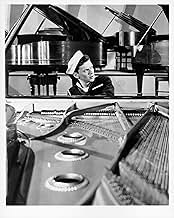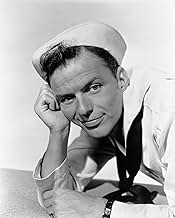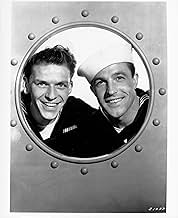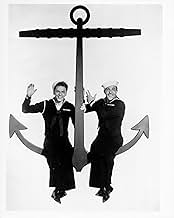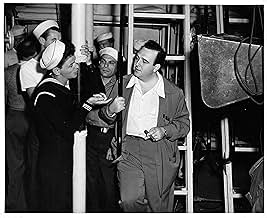AVALIAÇÃO DA IMDb
7,0/10
9,8 mil
SUA AVALIAÇÃO
Adicionar um enredo no seu idiomaA pair of sailors on leave try to help a movie extra become a singing star.A pair of sailors on leave try to help a movie extra become a singing star.A pair of sailors on leave try to help a movie extra become a singing star.
- Direção
- Roteiristas
- Artistas
- Ganhou 1 Oscar
- 5 vitórias e 4 indicações no total
Rags Ragland
- Police Sergeant
- (as 'Rags' Ragland)
Carlos Ramírez
- Carlos
- (as Carlos Ramirez)
- Direção
- Roteiristas
- Elenco e equipe completos
- Produção, bilheteria e muito mais no IMDbPro
Resumo
Reviewers say 'Anchors Aweigh' is a classic MGM musical with Gene Kelly, Frank Sinatra, and Kathryn Grayson. It features memorable dance sequences, vibrant Technicolor, and innovative camera work. Themes of love, friendship, and ambition are explored. Songs by Jule Styne and Sammy Cahn enhance the charm. Despite some criticisms of length and pacing, the film is celebrated for its entertainment value and historical significance.
Avaliações em destaque
Overall this is a delightful, light-hearted, romantic, musical comedy. I suppose a small case could be made for the movie being to long. But I'm not sure what you would cut out. The singing that Kelly and Sinatra do? No. The fabulous dancing that Kelly does? No. The time the movie takes to develop the story line and develop the relationships of the characters? No (that seems to be a common complaint many times that more recent movies don't develop the characters).
Some comment that Iturbi didn't bring much to the movie but this gives us a chance to see and hear a great talent from the 1040s. So what if he wasn't an actor? He was an important part of the movie as the basic plot was to get Grayson an audition with him.
Originally Katherine Grayson wanted to be an opera star. Louis B. Mayer brought her to MGM for a screen test that included an aria. During her audition in the movie there is a shot of the MGM brass nodding and smiling. You can just imagine it was like that when she had made her real screen test years before.
This movie is so full of life it is hard to hit all of the highlights. Great use was made of color and lighting throughout the movie. You can see why Frank Sinatra became the star he did. A nice counter-point in the movie is how Sinatra (a ladies man even then) played the role of wanting to just find a date while on leave. You'll feel good after seeing this movie. 7/10
Some comment that Iturbi didn't bring much to the movie but this gives us a chance to see and hear a great talent from the 1040s. So what if he wasn't an actor? He was an important part of the movie as the basic plot was to get Grayson an audition with him.
Originally Katherine Grayson wanted to be an opera star. Louis B. Mayer brought her to MGM for a screen test that included an aria. During her audition in the movie there is a shot of the MGM brass nodding and smiling. You can just imagine it was like that when she had made her real screen test years before.
This movie is so full of life it is hard to hit all of the highlights. Great use was made of color and lighting throughout the movie. You can see why Frank Sinatra became the star he did. A nice counter-point in the movie is how Sinatra (a ladies man even then) played the role of wanting to just find a date while on leave. You'll feel good after seeing this movie. 7/10
Since I first saw Anchors Aweigh in 1945, viewing it on videotape holds a lot of nostalgia for me. At age 15, it was easy for me to be drawn into the first of the great MGM Technicolor musicals. Now I am perhaps most interested in thinking about the future careers of the leading players. Though Sinatra had done a couple of negligible films soon after his emergence after his Dorsey days, as a solo singer, this was his first major film appearance. As another viewer noted, this seems almost to be a warm-up for On the Town. Sinatra may have had to work hard at it, but his dance with Kelly is credible, and he would do better in their next pairings. However, observing his physique, it's easy to see why he was caricatured as a string bean. Who would have imagined that within a decade he would win an academy award for acting, and go on to play many roles as a tough detective or leader in combat. Though Gene Kelly's personality and dancing dominated this film, his winsome performance did not suggest that he would become a major creative force, almost the iconic figure, for MGM musicals, where he developed a style of dance complementary to that of Fred Astaire. Finally, it was strange to see the fresh-faced Dean Stockwell and remember that he would later play a "thrill" killer in Compulsion, based on the Leopold-Loeb murder from the 1920s. An additional note: One reviewer praised the performance of Betty Garrett as Sinatra's love interest. She later played opposite him in On the Town, but Pamela Britton was featured in this film.
What surprises me here is how good Sinatra is. He's certainly playing against his later cock-sure image. No king of the walk here. Instead his Clarence (note the name) is likable but chock-full of self-doubt. And he's very good at being shy, retiring, and charming in a boyish way. It's a Sinatra as I've never seen him. On the other hand, there's the boldly self-assured Joe (Kelly) who dominates, as the two sailors try to get a big-time audition for the winsome Susan (Grayson). Somehow, however, they can't reach big-time impresario Jose Iturbi. But they and we have a good time trying.
Along the way, Kelly gets his legendary dance with cartoon mouse Jerry of Tom & Jerry, looking like it came right out of the Land of Oz. Then too, I like his really charming number with the little Mexican girl (McManus). Overall, however, it's the elaborate sets, glossy Technicolor, and sparkling personalities that shine. Frankly, I thought the musical selections were entertaining but nothing memorable. Also the storyline meanders a bit too much, particularly near the end. Note too how classical numbers are worked into the selections, quite typical for that time. I guess producers wanted to broaden the musical appeal, and lend a touch of 'class'.
All in all, the movie's MGM at it's glossy best. And though a bit overlong, the results still fit the classic bill, along with the perfect pairing of the two male leads.
Along the way, Kelly gets his legendary dance with cartoon mouse Jerry of Tom & Jerry, looking like it came right out of the Land of Oz. Then too, I like his really charming number with the little Mexican girl (McManus). Overall, however, it's the elaborate sets, glossy Technicolor, and sparkling personalities that shine. Frankly, I thought the musical selections were entertaining but nothing memorable. Also the storyline meanders a bit too much, particularly near the end. Note too how classical numbers are worked into the selections, quite typical for that time. I guess producers wanted to broaden the musical appeal, and lend a touch of 'class'.
All in all, the movie's MGM at it's glossy best. And though a bit overlong, the results still fit the classic bill, along with the perfect pairing of the two male leads.
In the Citadel film series book The Films of Gene Kelly, Anchors Aweigh is described as a kingpin of a musical. I sure can't do better than that. It's such an important film in both the careers of Gene Kelly and Frank Sinatra. Kathryn Grayson didn't do too badly with this either.
Louis B. Mayer had lent Gene Kelly out to Columbia where Harry Cohn had an inspiration to let Kelly choreograph his own numbers and because of it, Cover Girl became a classic. So if Mayer didn't learn a lesson, producer Joe Pasternak did and allowed Kelly artistic control. When Anchors Aweigh was finished, Fred Astaire at last had a dancing rival for monarch of cinema dance.
The main number everyone talks about with Gene Kelly here is the dance with Jerry Mouse. Originally Kelly wanted to do the number with Walt Disney's Mickey Mouse, but Disney wasn't lending Mickey out to nobody. Mickey would have to wait until Who Framed Roger Rabbit to do an outside film. Not to worry because MGM had it's own animated rodent one half the team of Tom and Jerry.
Kelly as dancer always strived to do something new and different on screen as did Fred Astaire. For the next dozen years, these two were allowed all kinds of artistic control and were praised for their work even if the films themselves weren't up to snuff. It was like each inspired the other to bigger and better creativity, Kelly for MGM, Astaire for MGM and any number of other studios. In Anchors Aweigh, Kelly got Sinatra to dance a bit. In fact Frank Sinatra always gave credit to Gene Kelly for showing him how musicals should be done as he gave credit to both Burt Lancaster and Montgomery Clift for their help in earning him is Oscar for From Here to Eternity.
When Frank Sinatra had half of his contract bought from RKO by MGM he insisted on a little artistic creativity on his own. He'd become friends with the songwriting team of Jule Styne and Sammy Cahn. In his autobiography Sammy Cahn tells about how Sinatra insisted that they write his songs for this film. Louis B. Mayer gave in and the team wrote some really fine ballads for him to sing. One of my favorite Sinatra numbers comes from Anchors Aweigh, I Fall in Love Too Easily. Frank sings it accompanying himself on the piano at an empty Hollywood Bowl. It's Sinatra at his best.
With Jule Styne and later with Jimmy Van Heusen, Sammy Cahn richly earned the title of having put more song lyrics in Frank Sinatra's mouth than any other person. They were lifetime friends and Cahn always credited Sinatra with this milestone boost in his career.
On a bet Styne and Cahn said they could write a song just using a chromatic scale. They proved it in Anchors Aweigh when Kathryn Grayson put her soprano to work on All of a Sudden My Heart Sings. She also did some classical numbers.
Here singing in fact is the basis of the plot. Two sailors on leave through a combination of circumstances meet up with Kathryn Grayson and her orphaned nephew Dean Stockwell. Trying to fix her up with Sinatra, Kelly says he can get her an audition with Jose Iturbi. They spend the film trying to accomplish just that.
My only disappointment in Anchors Aweigh was that Pamela Britton, who plays the waitress 'Brooklyn' never got a number herself. She had gotten rave reviews from her performance as Meg Brockie in Brigadoon on Broadway and that's what brought her to Hollywood. I have a suspicion she had a number that was cut and somewhere in MGM's vaults it might still be.
Anchors Aweigh is a great example of why musicals just aren't made any more. All that creative talent was under contract to Metro-Goldwyn- Mayer. If you had to pay market value for it, the cost might retire some third world country's debt.
But the film results would be extraordinary.
Louis B. Mayer had lent Gene Kelly out to Columbia where Harry Cohn had an inspiration to let Kelly choreograph his own numbers and because of it, Cover Girl became a classic. So if Mayer didn't learn a lesson, producer Joe Pasternak did and allowed Kelly artistic control. When Anchors Aweigh was finished, Fred Astaire at last had a dancing rival for monarch of cinema dance.
The main number everyone talks about with Gene Kelly here is the dance with Jerry Mouse. Originally Kelly wanted to do the number with Walt Disney's Mickey Mouse, but Disney wasn't lending Mickey out to nobody. Mickey would have to wait until Who Framed Roger Rabbit to do an outside film. Not to worry because MGM had it's own animated rodent one half the team of Tom and Jerry.
Kelly as dancer always strived to do something new and different on screen as did Fred Astaire. For the next dozen years, these two were allowed all kinds of artistic control and were praised for their work even if the films themselves weren't up to snuff. It was like each inspired the other to bigger and better creativity, Kelly for MGM, Astaire for MGM and any number of other studios. In Anchors Aweigh, Kelly got Sinatra to dance a bit. In fact Frank Sinatra always gave credit to Gene Kelly for showing him how musicals should be done as he gave credit to both Burt Lancaster and Montgomery Clift for their help in earning him is Oscar for From Here to Eternity.
When Frank Sinatra had half of his contract bought from RKO by MGM he insisted on a little artistic creativity on his own. He'd become friends with the songwriting team of Jule Styne and Sammy Cahn. In his autobiography Sammy Cahn tells about how Sinatra insisted that they write his songs for this film. Louis B. Mayer gave in and the team wrote some really fine ballads for him to sing. One of my favorite Sinatra numbers comes from Anchors Aweigh, I Fall in Love Too Easily. Frank sings it accompanying himself on the piano at an empty Hollywood Bowl. It's Sinatra at his best.
With Jule Styne and later with Jimmy Van Heusen, Sammy Cahn richly earned the title of having put more song lyrics in Frank Sinatra's mouth than any other person. They were lifetime friends and Cahn always credited Sinatra with this milestone boost in his career.
On a bet Styne and Cahn said they could write a song just using a chromatic scale. They proved it in Anchors Aweigh when Kathryn Grayson put her soprano to work on All of a Sudden My Heart Sings. She also did some classical numbers.
Here singing in fact is the basis of the plot. Two sailors on leave through a combination of circumstances meet up with Kathryn Grayson and her orphaned nephew Dean Stockwell. Trying to fix her up with Sinatra, Kelly says he can get her an audition with Jose Iturbi. They spend the film trying to accomplish just that.
My only disappointment in Anchors Aweigh was that Pamela Britton, who plays the waitress 'Brooklyn' never got a number herself. She had gotten rave reviews from her performance as Meg Brockie in Brigadoon on Broadway and that's what brought her to Hollywood. I have a suspicion she had a number that was cut and somewhere in MGM's vaults it might still be.
Anchors Aweigh is a great example of why musicals just aren't made any more. All that creative talent was under contract to Metro-Goldwyn- Mayer. If you had to pay market value for it, the cost might retire some third world country's debt.
But the film results would be extraordinary.
Anchors Aweigh is not a favourite of mine by all means, but I do enjoy it. It is overlong, the story is somewhat slight and the dialogue is unexceptional. Despite its failings, it is enjoyable. The production values are pleasing to the eye, while the score and songs are very pleasant and the choreography sprightly. The direction is good enough, while the pace while slightly mannered I had little problem with, as there are certain delights that stop the film from being dull. The cast, dancing and singing are excellent. Gene Kelly is always likable and here is no exception, while Frank Sinatra delights with his beautiful voice and and Kathryn Grayson is graceful and beautiful. The real delight though is the film's most famous sequence and no surprise really, the sequence when Kelly dances with Jerry of Tom and Jerry fame is as clever as it is memorable. So overall, not exceptional by all means, but there is much to enjoy still. 7/10 Bethany Cox
Você sabia?
- CuriosidadesWhen the dance sequence with Gene Kelly and Jerry Mouse was screened for MGM executives, someone noticed that, although Gene Kelly's reflection shone on the floor during his dancing, Jerry's did not. This required animators William Hanna, Joseph Barbera, and their team to go back and draw Jerry's reflection on the floor as he was dancing.
- Erros de gravaçãoWhen Clarence is singing to the waitress in the restaurant, there is a picture of Susita on the wall. When seen at a distance, her head is tilted to the left, but in a closeup, her head is vertical.
- Citações
Jerry Mouse: Look at me, I'm dancing.
- Cenas durante ou pós-créditos[in some versions, after the end credits]
TO FAMILIES AND FRIENDS OF SERVICEMEN AND WOMEN:
Pictures exhibited in this theatre are given to the armed forces for showing in combat areas around the world.
WAR ACTIVITIES COMMITTEE MOTION PICTURE INDUSTRY
- ConexõesEdited into American Masters: Gene Kelly: Anatomy of a Dancer (2002)
- Trilhas sonorasAnchors Aweigh
(1906) (uncredited)
Music by Charles A. Zimmerman
Played off-screen during the opening credits
Played by a Navy Band conducted by José Iturbi
Principais escolhas
Faça login para avaliar e ver a lista de recomendações personalizadas
- How long is Anchors Aweigh?Fornecido pela Alexa
Detalhes
- Data de lançamento
- País de origem
- Idiomas
- Também conhecido como
- Anchors Aweigh
- Locações de filme
- Empresa de produção
- Consulte mais créditos da empresa na IMDbPro
Bilheteria
- Faturamento bruto mundial
- US$ 2.556
- Tempo de duração2 horas 20 minutos
- Proporção
- 1.37 : 1
Contribua para esta página
Sugerir uma alteração ou adicionar conteúdo ausente

Principal brecha
By what name was Marujos do Amor (1945) officially released in India in English?
Responda


